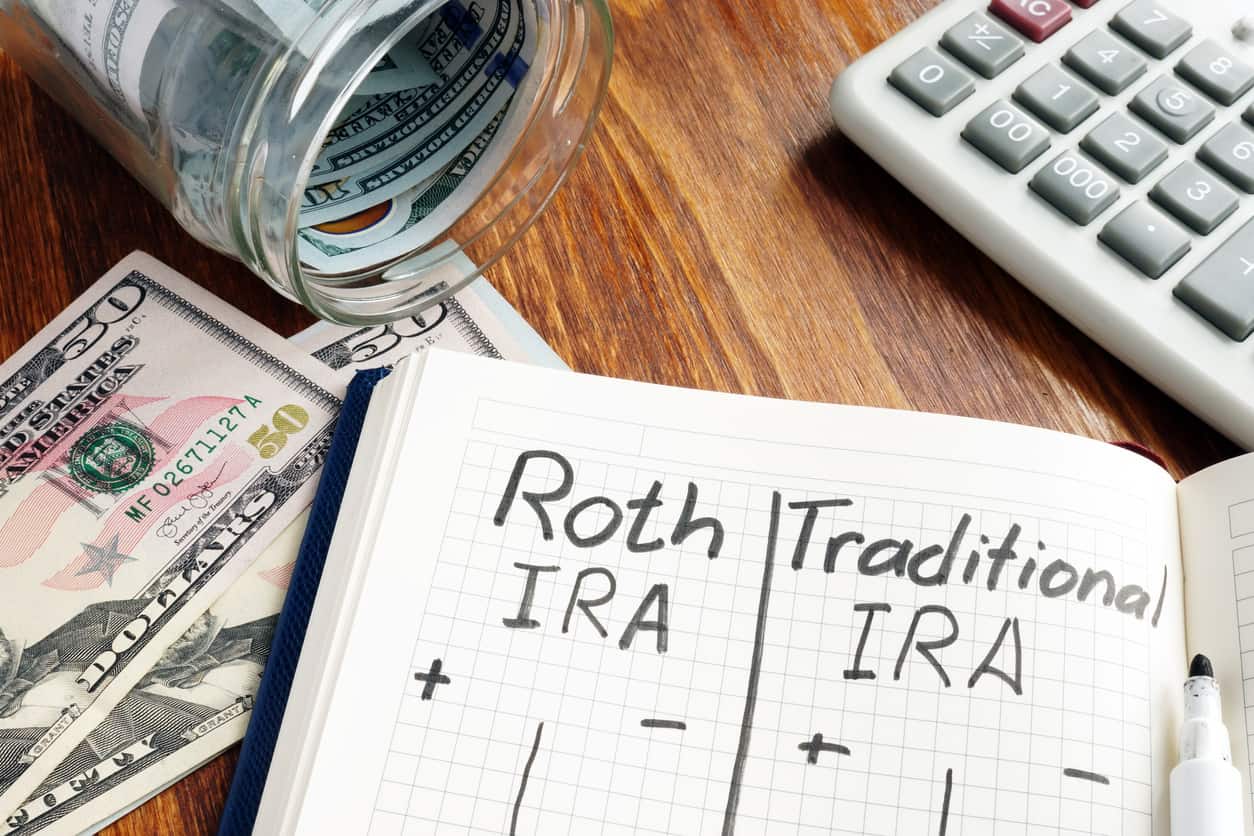To make Wealthtender free for readers, we earn money from advertisers, including financial professionals and firms that pay to be featured. This creates a conflict of interest when we favor their promotion over others. Read our editorial policy and terms of service to learn more. Wealthtender is not a client of these financial services providers.
➡️ Find a Local Advisor | 🎯 Find a Specialist Advisor

In almost all cases (assuming your Modified Adjusted Gross Income allows it), you should prefer to contribute annually to a Roth IRA rather than to a traditional IRA.
It was in 1993, as a postdoctoral fellow at Texas Tech University, that I had a fateful conversation about saving for retirement. I got chatting with a grad student who was already setting aside money and investing for his retirement, although he was only in his twenties. The penny dropped: “I guess I should be doing the same,” I thought.
A visit to the Texas Tech library introduced me to the Morningstar Directory of Mutual Funds. After spending three weeks’ worth of spare time learning how to use the directory to pick funds, I signed up for my first IRA and sent a modest contribution of $1000. Making just over $31,000 with a family of four, it was hard to spare more than that.
Back then, the only IRA option I had was the traditional plan, established by the Employee Retirement Income Security Act of 1974 (ERISA). It was over two decades later that the Roth IRA was established by the Taxpayer Relief Act of 1997.
Had the Roth IRA existed in 1993, I’d have chosen that type of account. You are likely better served by a Roth IRA than a traditional one. Below I explain why and caveat with the few situations where that might not be so for you.
Table of contents
First, a Few Stats
If stats make your eyes glaze over, feel free to skip this section. It just points out the importance of retirement plans in general and IRAs in particular.
The Good Old Days of Pensions Are Gone
Decades ago, almost all American workers had a pension, a defined benefit plan. As of 2019, according to PensionRights.org, the numbers are far lower. Just 22% of full- and part-time American workers and 13% of private-sector workers participate in a pension plan.
You see, over time, corporate America realized they’d much rather let you, the worker, shoulder the market risk of investing for retirement. After all, if they invest for you and things go badly, they’d still be on the hook for your retirement.
Workplace Retirement Plans Let You Shoulder the Market Risk
Enter the 401(k) plan (plus the similar 403(b) plan for employees of public schools and certain tax-exempt organizations, and its lesser-known “cousin,” the 457 deferred compensation plan for state and local governments, hospitals, educational organizations, charitable organizations or foundations, and trade associations).
All these so-called defined contribution plans make no promise as to how much money you’ll have for retirement. That depends on what investments you choose and how well those happen to perform over the years and decades until you retire.
Many American Workers Don’t Even Have Access to Any Workplace Plans
Worse, according to the US Bureau of Labor Statistics, as of 2021, 32% of private industry workers had no access to a workplace retirement plan at all. This means millions of American workers don’t even have the “luxury” of taking investment risks away from their employers by saving through a workplace retirement plan.
All this makes the IRA even more important to your future financial health. According to the latest report from the IRS, as of the 2019 tax year, 49 million American taxpayers had traditional IRAs with an average balance of $188k; and 22 million had a Roth IRA with an average balance of $46k (some taxpayers have both types of accounts).
Roth vs. Traditional IRAs: Comparing the Features
The similarities between the two IRA Types:
- Contribution Limit: Your contribution is limited for both types of IRA by the lower of an IRS-imposed limit (for tax year 2022, $6000 with a $1000 catch-up amount if you’re 50 or older; for tax year 2023, $6,500 with a $1,000 catch-up amount if you’re 50 or older) and your earned income for the year. However, note that the Roth IRA has an additional limit (see below).
- Contribution Deadline: You can send your contributions to both types of plans until “Tax Day” of the following year.
The differences between the two IRA Types:
- Income-Based Contribution Limit: While there’s no income-based limitation on your ability to contribute to your traditional IRA, there is such a limit for the Roth IRA, as discussed in the next section below. If your MAGI is higher than the ranges shown, you cannot contribute to a Roth IRA (though you can make a “backdoor” contribution by contributing to a traditional IRA and converting that to a Roth IRA – a process that is fraught with many caveats and potentially hefty tax liability).
- Tax Deduction in the Year of the Contribution: Contributions to a Roth IRA cannot be deducted from your taxable income. Contributions to a traditional plan may be partially or fully deductible, depending on whether you or your spouse are covered by a retirement plan at work, and on your MAGI per IRS rules. Generally, if neither you nor your spouse, if any, are covered by a workplace retirement plan, your contribution (up to the above-mentioned IRS limits) is fully deductible against this year’s taxes.
- Taxes and/or Penalties on Withdrawals: Withdrawals from Roth IRAs of amounts contributed to the plan are always tax and penalty-free.
- Withdrawals of earnings are also tax and penalty-free if you’re at least 59½ years old and the first contribution was made to the account at least five years earlier.
- Roth IRA withdrawals of earnings that don’t meet the above requirements on your age and the age of the account may avoid a 10% federal penalty and all taxes if you’re completely and permanently disabled, up to $10k (lifetime limit) withdrawn for a first-time home purchase, withdrawals made to your beneficiary or estate.
- Generally, any earnings or contributions to a traditional IRA that were previously deducted are subject to income tax in the year they’re taken. Withdrawals made prior to age 59½ are generally also subject to a 10% federal penalty, with some exceptions (see below).
- Traditional IRA withdrawals are subject to a 10% federal penalty if you’re younger than 59½ unless you’re totally and permanently disabled, the withdrawal is made to your beneficiary or estate, or to a reservist ordered or called to active duty after 9/11/2001 for more than 179 days, up to $10k (lifetime limit) withdrawn for a first-time home purchase, made to cover post-secondary education expenses, for certain unreimbursed medical expenses, to cover an IRS levy on the IRA, for health insurance premiums once you’ve received unemployment compensation for 12 consecutive weeks, or if you take substantially equal periodic payments under IRS guidelines.
- Required Minimum Distributions (RMDs): There are no RMDs for Roth IRAs during your lifetime. Traditional IRAs are subject to RMDs, so you must start withdrawing (and paying taxes on such withdrawals) by April 1 of the year following when you turn 72 and by December 31 of each subsequent year. The RMD amount is determined by the IRS and is intended to approximately deplete the IRA by your death. Failure to withdraw your RMD can subject you to confiscatory penalties of 50% of the amount you should have withdrawn and didn’t. The IRS may waive this penalty if your under-withdrawal was made due to a “reasonable error” and you file the proper paperwork.
Highlights of IRS Changes for IRAs in 2023
Source: IRS.gov
The income ranges for determining eligibility to make deductible contributions to traditional Individual Retirement Arrangements (IRAs), to contribute to Roth IRAs, and to claim the Saver’s Credit all increased for 2023.
Taxpayers can deduct contributions to a traditional IRA if they meet certain conditions. If, during the year, either the taxpayer or the taxpayer’s spouse was covered by a retirement plan at work, the deduction may be reduced or phased out until it is eliminated, depending on filing status and income. (If neither the taxpayer nor the spouse is covered by a retirement plan at work, the phase-outs of the deduction do not apply.) Here are the phase‑out ranges for 2023:
- For single taxpayers covered by a workplace retirement plan, the phase-out range is increased to between $73,000 and $83,000, up from between $68,000 and $78,000.
- For married couples filing jointly, if the spouse making the IRA contribution is covered by a workplace retirement plan, the phase-out range is increased to between $116,000 and $136,000, up from between $109,000 and $129,000.
- For an IRA contributor who is not covered by a workplace retirement plan and is married to someone who is covered, the phase-out range is increased to between $218,000 and $228,000, up from between $204,000 and $214,000.
- For a married individual filing a separate return who is covered by a workplace retirement plan, the phase-out range is not subject to an annual cost-of-living adjustment and remains between $0 and $10,000.
The income phase-out range for taxpayers making contributions to a Roth IRA is increased to between $138,000 and $153,000 for singles and heads of household, up from between $129,000 and $144,000. For married couples filing jointly, the income phase-out range is increased to between $218,000 and $228,000, up from between $204,000 and $214,000. The phase-out range for a married individual filing a separate return who makes contributions to a Roth IRA is not subject to an annual cost-of-living adjustment and remains between $0 and $10,000.
The income limit for the Saver’s Credit (also known as the Retirement Savings Contributions Credit) for low- and moderate-income workers is $73,000 for married couples filing jointly, up from $68,000; $54,750 for heads of household, up from $51,000; and $36,500 for singles and married individuals filing separately, up from $34,000.
The amount individuals can contribute to their SIMPLE retirement accounts is increased to $15,500, up from $14,000.
Details on these and other retirement-related cost-of-living adjustments for 2023 are in Notice 2022-55, available on IRS.gov.
Why You Should Almost Certainly Prefer the Roth IRA over a Traditional IRA
Most of the time, a Roth IRA will likely be the better option for you vs. a traditional IRA for the reasons discussed below. Of course, you should always discuss your specific circumstances with your tax accountant or financial advisor to ensure you choose the best option for you.
Tax Break Timing
The main difference between the two types of IRAs is the timing of your tax break. For the traditional IRA, it’s when you file your taxes for the year of your contribution. For the Roth, it’s when you withdraw the money. Here are several reasons why you should prefer the Roth because of this difference.
- Tax rates are historically low now, and the national debt is huge and climbing, so there’s a pretty good chance that tax rates will be higher when you retire.
- Although typically, your income will be lower in retirement, your taxable income may not be lower. First, you’ll probably get some Social Security benefits which may be at least partially taxable. Next, you may do some consulting or other part-time work even after you retire. Third, you will almost certainly have income from investments, and with the larger portfolio you need to fund retirement, that may generate a lot of taxable income. Fourth, many of your deductions will likely shrink or disappear by the time you retire – no child tax credit, lower mortgage interest deduction (if any), fewer (if any) business expense deductions, etc.
“I serve military personnel and retirees who may have pension income that, when added to Social Security benefits, means they will not likely be in the lowest tax bracket even when they stop working,” said Mike Hunsberger, ChFC and owner of Next Mission Financial Planning. “If they are in higher tax brackets, we’ll map out their projected income, required minimum distributions (RMDs), and potential opportunities for future Roth conversion.”
Since you make Roth contributions with post-tax money, all of your contributions and all of the earnings they generate will be available when you retire. For the traditional IRA, you get back a portion of the money through your current tax benefit. If you spend rather than invest that tax benefit, your savings will be much smaller when you retire.
Your workplace retirement plan is almost certainly tax-deferred (unless it’s the fairly rare Roth 401(k) plan), so a Roth IRA lets you diversify the tax treatment of your retirement accounts.
“We generally recommend that individuals consider contributing to a Roth IRA if they are under the income limit requirements to qualify for Roth IRA contributions,” said David Edmisten, CFP and Founder of Next Phase Financial Planning. “Many people already have tax-deferred retirement savings available through an employer-sponsored retirement plan like a 401k. The Roth IRA allows for tax-free growth of the investments and the potential for tax-free withdrawals of both contributions and earnings if age and holding period requirements are met. This can be a valuable tool for retirement planning and effectively managing future taxes by allowing clients to have a tax-free source of funds, in addition to their tax-deferred accounts.”
“I generally recommend using Roth early in your career when your earnings tend to be lower than they will later in life,” Dwight Dettloff, CFP, CPA, and Founder of Winding Trail Financial. “The idea is to pay tax at today’s lower rates and have tax-free distributions in retirement. During peak earning years, such as mid and later career, is when it tends to make the most sense to use a traditional IRA.”
Taxes and Penalties
Another important difference is in how withdrawals are taxed or subject to penalties. These differences raise another reason to prefer the Roth.
Although using retirement money before retirement is bad for you, if you’re in a real bind, the Roth IRA lets you use your contributions (and, in many cases, your earnings, too) with no income taxes and no penalties. Thus, a Roth IRA can serve double duty as part of your emergency fund.
RMDs and Age Limits
The different treatment of forced withdrawals and age limits on contributions raises another reason to prefer the Roth. The lack of RMDs means you can keep on earning tax-free returns on your Roth IRA balance until you need the money or until you leave it to your heirs upon your death.
The (Few) Cases When a Traditional IRA Is Better for You
If one of these is true for you, the Roth isn’t your better choice (if it’s even a choice at all).
- If your MAGI is too high, you aren’t eligible to contribute (directly) to a Roth IRA.
- If you’re less than five years from retirement and are opening a new IRA, you may not have access to any of the Roth money when you first retire until the five-year countdown is over.
The Mix-and-Match Case
In principle, you can contribute to both types of accounts in the same year as long as the total contribution doesn’t exceed your IRS-imposed limit for the year, and you’re eligible to contribute to a Roth IRA.
Thus, if for some reason you prefer a traditional IRA, there can be a case for contributing in parallel to both types of IRA. Specifically, if your income is too high for a traditional IRA contribution to be fully deductible, consider making a partial contribution to your traditional plan in an amount that can be deducted in full, and contribute the rest of your annual IRS limit to a Roth.
The Bottom Line
In almost all cases (assuming your MAGI allows it), you should prefer to contribute annually to a Roth IRA rather than to a traditional IRA. If you prefer the traditional IRA anyway, you would almost certainly do well to limit your traditional plan contribution to the amount you can deduct from your current taxes, contribute the balance of your allowed limit to a Roth (assuming again that your MAGI allows it), and make sure to invest in your taxable portfolio the tax benefit you got from making the deductible traditional plan contribution.
Find Your Next Financial Advisor on Wealthtender
📍 Click on a pin in the map view below for a preview of financial advisors who can help you decide if a Roth or Traditional IRA is best for you, and then help you reach your money goals with a personalized plan. Or choose the grid view to search our directory of financial advisors with additional filtering options.
📍Double-click or pinch pins to view more.
Disclaimer: This article is intended for informational purposes only, and should not be considered financial advice. You should consult a financial professional before making any major financial decisions.

About the Author
Opher Ganel, Ph.D.
My career has had many unpredictable twists and turns. A MSc in theoretical physics, PhD in experimental high-energy physics, postdoc in particle detector R&D, research position in experimental cosmic-ray physics (including a couple of visits to Antarctica), a brief stint at a small engineering services company supporting NASA, followed by starting my own small consulting practice supporting NASA projects and programs. Along the way, I started other micro businesses and helped my wife start and grow her own Marriage and Family Therapy practice. Now, I use all these experiences to also offer financial strategy services to help independent professionals achieve their personal and business finance goals. Connect with me on my own site: OpherGanel.com and/or follow my Medium publication: medium.com/financial-strategy/.
Learn More About Opher
To make Wealthtender free for readers, we earn money from advertisers, including financial professionals and firms that pay to be featured. This creates a conflict of interest when we favor their promotion over others. Read our editorial policy and terms of service to learn more. Wealthtender is not a client of these financial services providers.
➡️ Find a Local Advisor | 🎯 Find a Specialist Advisor

































